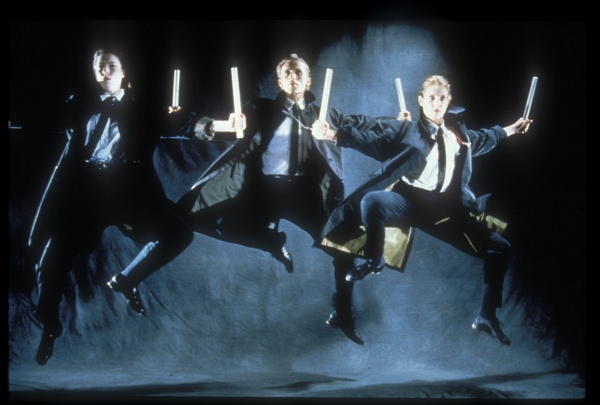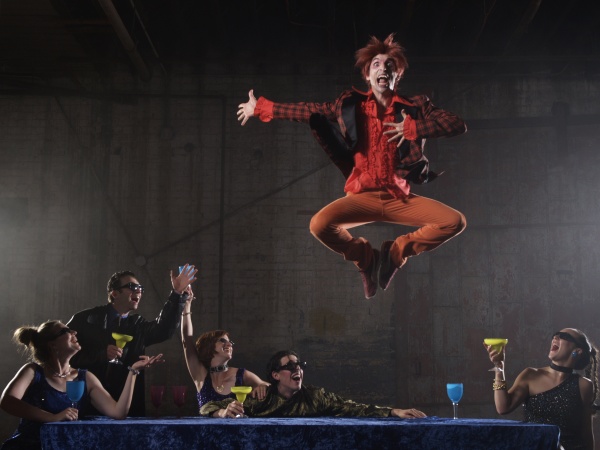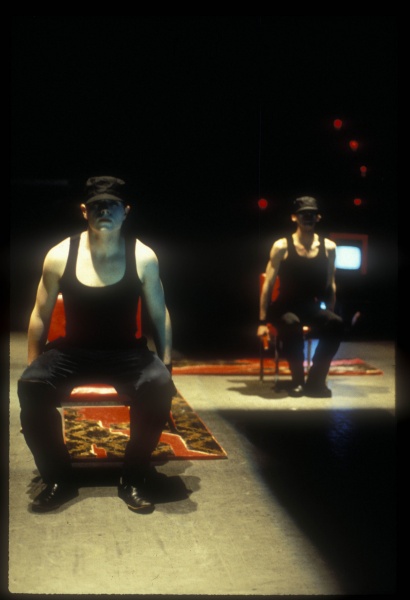Between Fire and Ice: Ragnarok at the McGuire
Dean Seal went to Joe Chvala's "Mjollnir II" and was blown away; our favorite religion writer finds paganism interesting.



Joe Chvala has put together a world-class, vibrant piece of performance that drills into the audience from a complex multiplicity of angles. Between Fire and Ice (Mjollnar II) had its brief run at the beginning of December at the McGuire Theater at the Walker Art Center, and it was a cavalcade of brilliant choreography, dedicated performers, ancient and modern music, an array of modern visual technology, and hilarious and wonderful characterizations. In sum: It kicked living bum-cake.
Chvala says in his director’s notes that in his first draft (Mjollnar) in 1995 he was “trying to make sense of the 20th century- both a brilliant and bloody time.” He had hoped that the turn of new millennium would start with a beautiful ray of hope, and as we moved into it, “the world seemed to go in every possible wrong direction.”
The nonlinear “event” of this re-staging starts us in ice
in the Nordic mythology of Loki the Trickster, Odin the All-Father, Sigurd the Dragonslayer, and an array of intermingling others. Chvala as director has an enormous generosity with the talent he brings to the task. Bringing in Ruth MacKenzie sets the stage for her tonal and atonal Finnish harmonics; letting Savage Aural Hotbed loose as the electronic orchestra establishes a fierce and textured base for the dancers to leap from. In the first half, MacKenzie’s trio of singers takes off on their 3/4 time yowling that pulls your senses back 3,000 years in a snap; in the second half, the industrial wasteland is invoked by the band that takes the beats from the dancers and adds weird instrumentation that turns them into the Klezmer Band From Hell. In both halves, the components blend and support each other in a weaving, flexible counterpoint.
But it goes beyond that. Chvala combines dance styles and rhythm styles that snap us back and forth through the centuries. Recognizing that tap dancing is both rhythm and movement is one thing; combining it with pounding of sticks, taking those sticks into taiko-like drumming; combining hand-claps and table-pounding into choreography lead-ins to the dance stuff makes it all more three-dimensional somehow. It’s like dancers are released to really, really get far into the beat in a way that I have never seen so fully realized—the dancers are their music.
Chvala as mythologist starts us in a dreamscape of icy purity, but then hauls us through the gory mythology that talks about how awful we can be as people. The story of the vengeful wife who kills her children to spite her husband echoes through the mythology of Greece, in Medea; the details of feeding the pieces of their hearts outstrips the ugliness of Coriolanus, who fed the bones of his enemy’s sons to him in bread. All of Europe seems to be about devouring its children in vengeance, and Chvala homes in on this dramatically in the first half.
In the second half, he brings us into the 20th century with costuming from every decade, with music that is more insistently electric and less ancient, with choreography that is sometimes more threatening than enjoyable. The closing tap piece, with the dancers in black and white, side-lit in bright red, echoed the color scheme of Nazi Germany, and in this context it brought home the ugly power of Nordic and Teutonic mythology that Hitler tried to steal and use in empowering his Ubermenschen. As the troop marched towards us, scowling, I realized I had never seen malevolent tap-dancing before. And it is scary seeing something so cool being made so angry, so destructive.
What’s really great dramatically about this is Chvala’s determination to go into neglected mythology like it was a mining operation. He digs into this to see what it’s about, to see why it worked back then well enough to survive into the present, and then modernizes it to make it work in the here and now. Like any great religion, or any cohesive culture, traditions survive because the elements that carry meaning make it through the crucible of time, and the slag slides off to the side. The all-slag traditions are burned to a crisp, and the ones that carry meaning or emotion or a core of story-telling come out glowing.
More gushing is required here. Chvala and Company as dancers put up one of the most demanding, complex, amazing, and exhausting pieces of work that I have ever seen. Special kudos in the first half are due for Karla Grotting and Megan McClellan for their astonishing duet, and for Chvala’s Loki, the dance-hall comedian who dances his way into your heart in order to be more perfectly positioned to stab you. He’s funny, moving, wildly entertaining, and frightening.
The ensemble packs in this barrage of stimuli with only one break. Otherwise, you are held in thrall until exhaustion. When Chvala did it in 1995, I couldn’t go, and I asked him if he was going to remount it, and he said “No, it’s too much work, it’s too exhausting.” Well, he must have topped himself. I’m glad he blew the dust off and took another whack at it, and I’m glad the Walker put him up to it.
Because this is a Walker show, and this website is a Walker website, I feel the need to point out that my night was not perfect. In the show, the electronic video screen seemed to me to be useful as a set-up, but only a distraction if something was happening on the stage. The rich production budget seemed to become seductive, and the screen became a scene stealer instead of a blended component. In the rest of the show, you always knew where the spotlight was.
The experience of the McGuire theater was superb, as a performance space. As a public accommodation, I was disappointed. The beverages at intermission were only available at a bar that was hard to find and already packed with people attending other events; the bar seemed terribly understaffed. The signage seems nonexistent; if I was a diabetic running low on blood sugar, I never would have found the orange juice in time. The parking ramp was worse; when the show let out, people were trapped underground in a sea of carbon monoxide for over half an hour. It seemed to be a very unfriendly place for a show, in marked contrast to this very delightfully human experience on the stage. This giant box of a new building, which reminds me of an anniversary present birthing a pair of ski goggles, has a warm heart beating under its cold, forbidding exterior, and it shouldn’t be so archly designy that it’s hard to get around inside. But it is. It’s going to be a cold day in Ragnarok before I am tempted to battle my way back into the place for another show.